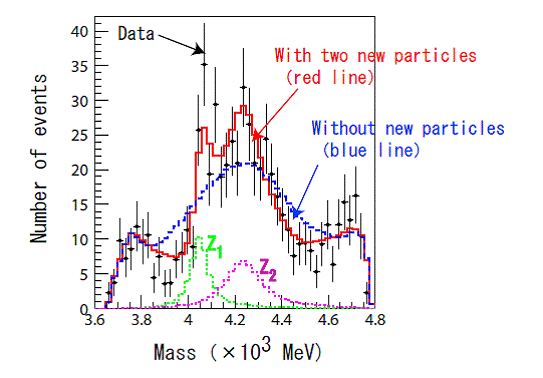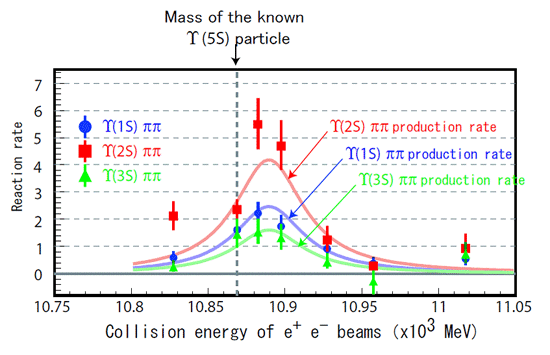An international team of researchers at the High Energy Accelerator Research organization (KEK) in Tsukuba, Japan, the "Belle collaboration"*1, has announced the discovery of three new exotic sub-atomic particles, labeled as Z1, Z2 and Yb. The Z1 and Z2 states have unit electric charge, by which these particles are clearly distinguished from normal quark-antiquark mesons, and thus can be identified as particles consisting of four quarks. The Yb structure may be the first clear example of an exotic hybrid particle, which contains the bottom quark and its anti-particle (an anti-bottom quark) as in a conventional meson but with an excited gluon as well.
In the past few years, a number of peculiar new particles, including the so-called X(3872), Y(4260), X(3940), Y(3940), have been found by the Belle and also by the BaBar experiment at the Stanford Linear Accelerator Center (SLAC). These new particles lie in the mass region from 4 to 4.5 times the proton mass, and decay into "J/psi" or "Psi-prime" particles and pi-mesons. Here the J/psi and Psi-prime particles are examples of so-called "charmonium" mesons, bound states of a charm quark and its anti-particle (an anti-charm quark). Last year, the Belle team reported the first exotic particle containing a charm and anti-charm quark with non-zero electric charge, called the Z(4430).
The Z1 and Z2 particles were found in the decay products of B-mesons (mesons containing a bottom quark) that are produced in large numbers at the KEKB "B-factory", an electron-positron collider at the KEK laboratory. The Belle team searched for new states, which decay into a pi-meson and a so-called "chi-sub-c1" meson, which is another well known charmonium meson. The measured mass values were 4051 MeV for the Z1 and 4248 MeV for the Z2 . The newly discovered Z1 and Z2 states have non-zero electric charge, as was the case for the Z(4430) particle. To build a composite particle having a net unit charge, at least two additional quarks (for example, an up quark and an anti-down quark) are necessary. Therefore, data on exotic particles with non-zero electric charge attract special attention from the world's physics community. The discovery of the Z1 and Z2 states, following that of the Z(4430) last year, not only provides more evidence for the existence of particles consisting of four quarks, but also indicates that the first four-quark state is not a special case, and there should be more such particles.
Discoveries of exotic particles containing a charm and an anti-charm quark have stimulated the search for the possible existence of bottom-quark counterparts of such exotic particles. In 2005, BaBar at SLAC discovered a state called the Y(4260), which decays into a J/psi particle and two pions. The Y(4260) may be an example of a "hybrid particle" containing a charm quark, an anti-charm quark connected by an excited gluon. The newly discovered Yb structure may be the first example of an exotic counterpart with bottom and anti-bottom quarks. The Yb state was found in an energy scan at the KEKB accelerator; the Belle/KEKB team measured the production rate of a so-called "Upsilon" particle and two pions as a function of the collision energy of the electron and positron beams. Here the "Upsilon" particle is an example of a "bottomonium" meson, which is a bound state of a bottom-quark and an anti-bottom quark. The Belle team observed a dramatic increase of the production rate at 10,890 MeV, which may indicate the production of a new particle decaying into an Upsilon and two pions. Although there are other possible interpretations for this new structure, the result has attracted considerable attention as the first example of an exotic bottomonium particle.
Conventional hadron particles have been classified into two types; "mesons" consisting of a quark and an anti-quark, or "baryons" consisting of three quarks. The discoveries of exotic particles both by Belle and BaBar have shed light on new classes of hadrons, formed by the strong interaction of quarks. The discovery of the Z1, Z2 and Yb states by the Belle team implies that there could be more such particles of the new class, including systems containing the bottom quarks. It is critical to clarify the entire spectrum of exotic particles, in order to understand the phenomena of quark confinement as well as the formation of matter by the strong interaction.
[ Media Contact ] Youhei Morita, KEK Public Relations Office
+81 29-879-6047
|
 |
Figure 1 : Distribution of mass for the combination of a pi-meson and a chi-sub-c1 meson. The peaks at 4,050 MeV (million electron volts) and 4,250 MeV correspond to the discovered Z1 and Z2 particles. These particles are produced in the B-meson decay; B-meson  K-meson + Z1 or Z2, and then decay into a pi-meson and a chi-sub-c1 meson. K-meson + Z1 or Z2, and then decay into a pi-meson and a chi-sub-c1 meson.
|
 |
Figure 2 : Measured production rate of an upsilon-meson and two pi-mesons as a function of the collision energy of e+ e- beams. The results are shown for three types of Upsilon-mesons [ (1S)-blue, (1S)-blue,  (2S)-red, (2S)-red, (3S)-green]. The production rate peaks at 10,890 MeV for all the three results. The vertical dotted line indicates the energy of the well-known (3S)-green]. The production rate peaks at 10,890 MeV for all the three results. The vertical dotted line indicates the energy of the well-known  (5S) particle. (5S) particle.
|
|



